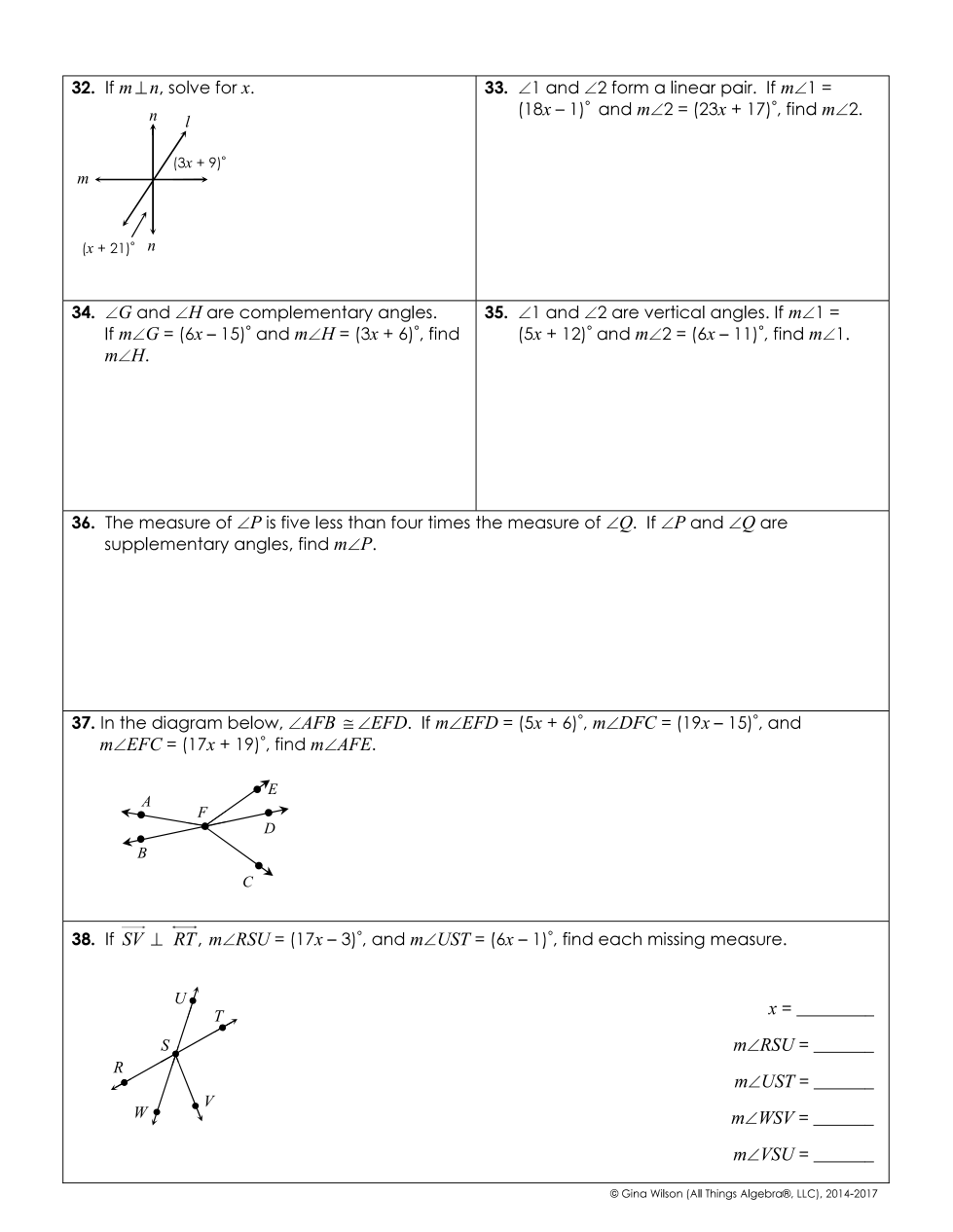If m l n, solve for x. Angle 1 and Angle 2 form a linear pair. If m Angle 1 = (18x - 1)° and m Angle 2 = (23x + 17)°, find m Angle 2. Angle G and Angle H are complementary angles.... If m l n, solve for x. Angle 1 and Angle 2 form a linear pair. If m Angle 1 = (18x - 1)° and m Angle 2 = (23x + 17)°, find m Angle 2. Angle G and Angle H are complementary angles. If m Angle G = (6x - 15)° and m Angle H = (3x + 6)°, find m Angle H. Angle 1 and Angle 2 are vertical angles. If m Angle 1 = (5x + 12)° and m Angle 2 = (6x - 11)°, find m Angle 1. The measure of angle P is five less than four times the measure of angle Q. If angle P and angle Q are supplementary angles, find m Angle P. In the diagram below, Angle AFB ≅ Angle EFD. If m Angle EFD = (5x + 6)°, m Angle DFC = (19x - 15)°, and m Angle EFC = (17x + 19)°, find m Angle AFE. If SV ⊥ RT, m Angle RSU = (17x - 3)°, and m Angle UST = (6x - 1)°, find each missing measure.

Understand the Problem
The questions are related to solving for angle measures in various geometric configurations involving complementary, supplementary, and linear pairs of angles.
Answer
Answer for screen readers
- ( x = 4 )
- ( m∠2 = 109^\circ )
- ( m∠H = 39^\circ )
- ( m∠1 = 127^\circ )
- ( m∠P = 143^\circ )
- ( m∠AFE ) depends on solved ( x )
Steps to Solve
- Linear Pair Angles (Problem 33)
Since angles 1 and 2 form a linear pair, their measures must add up to $180^\circ$.
Set up the equation: $$(18x - 1) + (23x + 17) = 180$$
- Combine Like Terms
Combine the $x$ terms and the constant terms: $$18x + 23x - 1 + 17 = 180$$
This simplifies to: $$41x + 16 = 180$$
- Isolate x
Subtract 16 from both sides to isolate the term with $x$: $$41x = 164$$
- Solve for x
Divide by 41: $$x = 4$$
- Finding Angle m∠2
Now substitute $x = 4$ back into the expression for $m∠2$: $$m∠2 = 23(4) + 17 = 92 + 17 = 109^\circ$$
- Complementary Angles (Problem 34)
For angles G and H which are complementary, set up the equation: $$(6x - 15) + (3x + 6) = 90$$
- Combine Like Terms
This simplifies to: $$9x - 9 = 90$$
- Isolate x
Add 9 to both sides: $$9x = 99$$
- Solve for x
Divide by 9: $$x = 11$$
- Finding m∠H
Now substitute $x = 11$ into the expression for $m∠H$: $$m∠H = 3(11) + 6 = 33 + 6 = 39^\circ$$
- Vertical Angles (Problem 35)
For angles 1 and 2 that are vertical angles: $$m∠1 = m∠2$$
Set the equations equal: $$(5x + 12) = (6x - 11)$$
- Isolate x
Rearranging gives: $$12 + 11 = 6x - 5x$$
This simplifies to: $$23 = x$$
- Finding m∠1
Now we substitute back into the equation for $m∠1$: $$m∠1 = 5(23) + 12 = 115 + 12 = 127^\circ$$
- Finding m∠P in Problem 36
Using the relationship given: Let $m∠Q = y$. Then: $$m∠P = 4y - 5$$
Set up the equation for supplementary angles: $$m∠P + m∠Q = 180$$
Substituting gives the equation: $$(4y - 5) + y = 180$$
- Combine Terms
This simplifies to: $$5y - 5 = 180$$
- Isolate y
Add 5 to both sides: $$5y = 185$$
- Solve for y
Dividing gives: $$y = 37$$
- Finding m∠P
Find $m∠P$: $$m∠P = 4(37) - 5 = 148 - 5 = 143^\circ$$
- Finding m∠AFE in Problem 37
Using the relationship of angles: Set $m∠AFE = z$. Since $\angle AFB = \angle EFD$, we set up: $$z + (5x + 6) = (19x - 15)$$
- Combine Terms
This simplifies to: $$z + 5x + 6 = 19x - 15$$
- Isolate z
Rearranging gives: $$z = 19x - 15 - 5x - 6$$
- Solve for x (would need values)
Then substitute back to find values.
- ( x = 4 )
- ( m∠2 = 109^\circ )
- ( m∠H = 39^\circ )
- ( m∠1 = 127^\circ )
- ( m∠P = 143^\circ )
- ( m∠AFE ) depends on solved ( x )
More Information
These angles highlight properties such as linear pairs, complementary and supplementary angle relationships, and vertical angles which are equal.
Tips
- Confusing complementary and supplementary angles.
- Forgetting to set angle measures equal
AI-generated content may contain errors. Please verify critical information